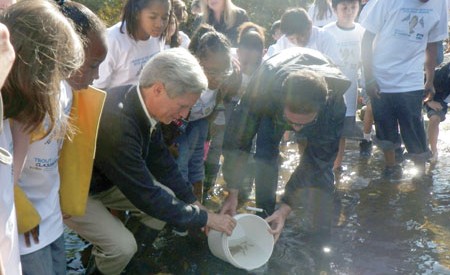When you were in grade school, odds are you had a classroom pet at some point—maybe a gerbil, a hamster, or even a rabbit if you were lucky. Students took turns taking care of the pet, feeding it, changing its dirty cage and so on as a way to garner a sense of responsibility and leadership. In Henry County in southern Virginia, they do something a little different in regards to having a class pet: instead of a small mammal in a cage, they have a cold water tank with dozens of fingerling trout.
The Trout in the Classroom (TIC) program was started over 20 years ago by several organizations, most notably Trout Unlimited, as a way for teachers to introduce more environmental themes into their curriculum. Classrooms are equipped with a tank, water chiller, filter, and trout eggs from a local hatchery. Throughout the year, the students witness the development of the trout from egg to fry to fingerling while monitoring their progress by collecting data, regulating feeding, and examining water quality. The final step is a field trip to a local trout river where the fingerlings are released.
Through the efforts of Martinsville orthodontist Dr. David Jones, who put up a significant sum of his own money to get the project off the ground. TIC was brought to southwest Virginia in 2005. It has since grown into one of the single largest programs in the country. This year, for the first time, the TIC program is raising all three species of Virginia trout – brook, brown, and rainbow – in 38 classroom tanks spread across six counties in Virginia and North Carolina. Through the program, students not only learn about a trout’s lifecycle, but the ecosystem as well.
“We use the whole thing to teach water quality, protection of natural resources, and good stewardship of environment,” says Brian Williams, one of Henry County TIC’s founders and program manager at the Dan River Basin Association (DRBA).
As an indicator species, trout are a marker of a healthy watershed, something TIC instills in participating students with a hands-on approach. By taking ownership of the trout, they connect the dots between a healthy river system, the environment, and their community. DRBA Education Outreach Coordinator Krista Hodges sees this didactic experience firsthand each time she enters a TIC classroom.
“The kids are really interested in taking care of the trout, but when they actually release them into the river they are really concerned about their trout,” she said.
She tells one story of a release day when the kids spotted a great blue heron upstream from where they were putting the trout in the water. The students became very concerned about the safety of their fish, demonstrating the links between predators, prey, and the ecosystem they learned in class.
The TIC program incorporates many different lessons besides the science and watershed education, including fine arts and social studies. Students write in journals about their experiences, illustrate ideal trout habitats, use mathematics to calculate feeding charts and survival rates, and study government and the history of the Smith and Dan rivers to examine why they are suitable as a trout ecosystem. All these lessons are geared toward the Standards of Learning test guidelines, so teachers do not have to choose between hands-on learning and helping their students succeed in the eyes of the state. The larger impact of the program on high-risk students has been dramatic, and cannot be understated, says Williams.
“Every year we have stories where teachers say they had a student who was falling through the cracks, failing grades, not coming to class or something,” he said. “Then they get interested in Trout in the Classroom and start coming in, feeding the trout, taking care of them, and grades change and turn around. You never know how you’re going to affect that one kid or a whole school.”
Williams says they have more requests for tanks from teachers and administrators than they can fill, a testament to the reputation of the TIC program. The DRBA and Trout Unlimited add to the excitement of release day by inviting political figures to witness the event; former Virginia Governor Tim Kaine and Senator Mark Warner are among those who have participated, and last year’s release was attended by NASCAR superstar Jimmy Johnson. The promise of a big event at the end of the project is a major motivator for the kids and is just another aspect of TIC that keeps them engaged in learning. By instilling a solid base on which to build a broader awareness of conservation and pride in a healthy environment and community, TIC reaches beyond just the classroom to, hopefully, become a way of life.
“When we first started, some kids didn’t even know the name of the Smith River that ran through their town, much less what a macro invertebrate is,” Williams said. “Now, just about every kid in Henry County and the surrounding counties has been exposed to water quality, macro invertebrates, trout, the habitat, all the things the river needs to stay healthy and clean, and that’s our objective.”








